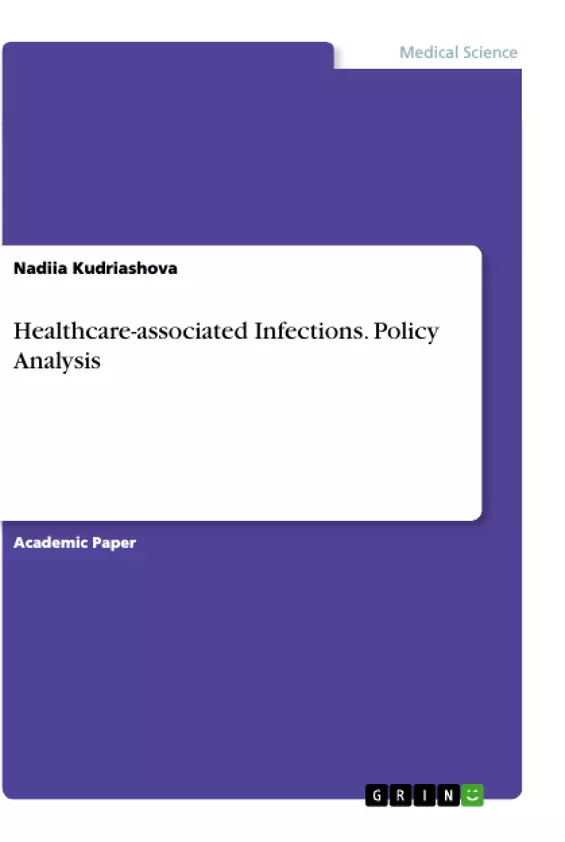Nosocomial infections, having arisen at the dawn of the first medical institutions, became an increasingly complex and urgent problem of medicine. In modern conditions, the incidence of nosocomial infections, to a certain extent, reflects the quality of medical care provided to the population and is one of the important components of economic damage in practical health care.
According to research conducted by a single methodology under the auspices of WHO in fourteen countries, an average 8% of hospitalized patients infections are infected with with nosocomial infections. In the European region, the incidence of nosocomial infections is more than 7%, in the United States - about 5%; mortality is 2.7% (El-Saed, Balkhy, & Weber, 2013). The most common variants of nosocomial infections include nosocomial pneumonia, urinary tract infections, catheter-associated infections, and pseudomembranous colitis, or antibiotic-associated diarrhea. It should be understood that the localization of nosocomial infection depends on both the etiology of the pathogen and the source of nosocomial infections. Approximately 1 in 10 cases ends in death (Boev & Kiss, 2016). However, at least half of the infections are preventable. Policies and programs to combat nosocomial infections are aimed at this prevention.
Inhaltsverzeichnis (Table of Contents)
- Healthcare-associated Infections: Policy Analysis
- Introduction
- The Prevalence and Impact of Nosocomial Infections
- Challenges in Combating Nosocomial Infections
- Epidemiological Surveillance and Prevention
- Multi-resistant Gram-negative Bacteria
- The Growing Threat of Antibiotic Resistance
- Surveillance and Research Programs
- Challenges in Data Collection and Reporting
- Conclusion
Zielsetzung und Themenschwerpunkte (Objectives and Key Themes)
This policy analysis explores the significant problem of healthcare-associated infections (HAIs), also known as nosocomial infections. The work examines the prevalence, impact, and challenges associated with HAIs, highlighting the need for effective prevention and control measures.
- The prevalence and impact of nosocomial infections on patient health and hospital resources
- The difficulties in combating HAIs, including the diversity of infectious agents, their transmission, and resistance to treatments
- The importance of epidemiological surveillance and prevention programs in reducing HAI rates
- The emergence of multi-resistant gram-negative bacteria as a major threat to patient care
- The global challenge of antibiotic resistance and its impact on HAI management
Zusammenfassung der Kapitel (Chapter Summaries)
- The first chapter provides an overview of HAIs, discussing their historical context and the growing recognition of their impact on patient outcomes and healthcare costs.
- The second chapter delves into the challenges associated with combating HAIs, highlighting the complex nature of infectious agents, their transmission, and resistance to treatments.
- The third chapter explores the role of epidemiological surveillance and prevention programs in reducing HAI rates, emphasizing the importance of data collection, analysis, and intervention strategies.
- The fourth chapter focuses on the emergence of multi-resistant gram-negative bacteria as a significant threat to patient care, discussing their resistance mechanisms and the impact on treatment options.
- The fifth chapter examines the global challenge of antibiotic resistance and its implications for HAI management, highlighting the need for research, development, and responsible antibiotic use.
- The sixth chapter discusses the challenges in data collection and reporting related to HAIs, emphasizing the lack of standardized methods and the consequences for accurate assessment and intervention.
Schlüsselwörter (Keywords)
Healthcare-associated infections, nosocomial infections, epidemiology, infection control, antibiotic resistance, multi-resistant gram-negative bacteria, patient safety, quality of care, healthcare policy, surveillance programs, prevention, data collection, reporting.
- Citar trabajo
- Nadiia Kudriashova (Autor), 2017, Healthcare-associated Infections. Policy Analysis, Múnich, GRIN Verlag, https://www.grin.com/document/500560



